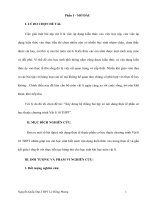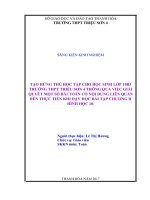Bài giảng Phụ gia thực phẩm - Chương 5: Chất chống oxy hóa
Bạn đang xem bản rút gọn của tài liệu. Xem và tải ngay bản đầy đủ của tài liệu tại đây (1.18 MB, 41 trang )
PART 2
FOOD ADDITIVES CONTRIBUTING TO IMPROVE
THE SHELF-LIFE
Chương 5: ANTIOXIDANTS
Group 4: Antioxidant
A food additive, which prolongs the shelf-life of foods by protecting against
deterioration caused by oxidation.
antibrowning agent
antioxidant
antioxidant synergist
1. Các chất chống nâu hóa
Nâu hóa là vấn đề
• Thực phẩm nguồn gốc thực vật có thể bị biến đổi hóa học
trong q trình:
sau thu hoạch,
chế biến,
hoặc lưu trữ,
Các phản ứng biến đổi màu (nâu hóa) được chia thành 2 loại:
1. Nâu hóa do enzyme
2. Nâu hóa khơng do enzyme.
Ví dụ:
- Nâu hóa trong q trình cắt rau quả tươi và tiếp xúc khơng khí?
- Nâu hóa trong quá trình thanh trùng nước quả?
Nâu hóa do enzyme là kết quả của:
- Oxy hóa các hợp chất polyphenols chuyển thành quinones,
- Được xúc tác bởi các enzyme polyphenol oxidase:
• PPO
• Tyrosinasa
• o-diphenol oxidase
• catechol oxidase
- Các phản ứng tiếp tục diễn ra và polymer hóa các quinones.
Kiểm sốt nâu hóa do enzyme:
1. Sử dụng phương pháp chần,
2. Acid hóa; ứng dụng sulfites
3. or sử dụng các chất thay thế sulfites như:
– ascorbic acid
– cysteine.
Các chất thay thế này hiệu quả kém hơn so với sulfites
Chemistry of browning reactions in foods
Chemistry of browning reactions in foods
• The optimum pH for PPO activity is between 5 and 7
• PPO is relatively heat labile
• and PPO-catalyzed reactions can be inhibited by:
acids
phenolic acids,
sulfites
ascorbic acid
Sulfites
• Sulfite may be applied as:
E220 Sulphur dioxide
E221 Sodium sulphite
E222 Sodium bisulphite,
E223 Sodium metabisulphite
E224 Potassium metabisulphite
E225 Potassium sulphite
E226 Calcium sulphite
E227 Calcium hydrogen sulphite,
E228 Potassium bisulphite
• Sulfite có nhiều dạng tồn tại ở dạng nào tùy thuộc vào bản
chất của thực phẩm
• Do đó nhiều chất tương đồng của sulfite được phát triển để
giải quyết vấn đề công nghệ.
E220 (sulphur dioxide) được sử dụng xử lý xơng quả chống
hóa nâu. Ngồi ra nó cũng có thể sử dụng điều chỉnh độ acid và
chất bảo quản vi sinh
E223 và E224 đặc biệt rất bền khi lưu trữ do đó sử dụng trong các
kho bảo quản là phù hợp.
E226 rất tan ít trong nước nên sử dụng được khi yếu tố hịa tan
khơng phải ưu tiên hàng đầu
Q trình oxy hóa (oxidation)
• Oxidation là một phản ứng hóa học chuyển các electron hoặc
hydrogen từ một cơ chất sang chất oxy hóa.
• Phản ứng oxy hóa tạo ra các gốc tự do (free radicals). Sau đó,
các gốc tự do này sẽ tạo ra phản ứng oxy hóa dây chuyền.
Oxidation
Oxy hóa làm biến đổi thực phẩm:
ơi hóa (rancidity),
mất mùi vị,
mất màu sắc
mất giá trị dinh dưỡng.
Oxidation
Mức độ oxy hóa phụ thuộc vào:
1. Tồn tại các chất oxy hóa tự nhiên trong thực phẩm,
2. Có mặt của oxy,
3. độ nhạy của cơ chất đối với phản ứng oxy hóa,
4. nhiệt độ và ánh sáng,
ANTIOXIDANTS
STABLISED RADICALS
ANTIOXIDANTS
PEROXIDE AND
FREE RADICALS
AH
ROO•
R•
RO•
Ascorbic Acid
Ascorbyl Palmitate
Ascorbyl Stearate
Calcium Ascorbate
Mixed Tocopherols Concentrate
Tocopherol, Alpha-
A•
AA
AX
NON RADICALS
ROOH
RH
ROH
Propyl Gallate
Tertiary Butylhydroquinone
Guaiac Resin
Butylated Hydroxyanisole
Butylated Hydroxytoluene
ANTIOXIDANTS
• Ascorbic acid, tocopherols, gallic acid, BHA and BHT
• Often a combination of two or more antioxidants is more
effective than any one used simply because of their synergistic
effects.
• The presence of other agents, such as citric acid, may also have
a synergistic effect, by reducing the availability of metallic ions
that may catalyse oxidation reactions.
.
ANTIOXIDANTS
• The use of the powerful synthetic antioxidants BHA, BHT and the gallic
acid is very restricted.
• Tocopherols, which can be either natural or synthetic, are less restricted
but are less effective in the protection of processed foods.
• Antioxidants cannot restore oxidized food; they can only retard the
oxidation process.
• The most effective use of antioxidants is therefore in the fats and oils
used in the manufacturing process.
ANTIOXIDANTS
SAFE
Low concentration required (0.010.02%)
ANTIOXIDANTS
Distribute at interfaces
Highly hydrophobic
In contact with air
Stable in processing conditions
• Regulated differently country by country
• Many antioxidant but few approved by:
Joint FAO/WHO Expert Committee on Food Additives (JECFA)
European Community’s Scientific Committee for Food (SCF)
ADI (mg/kg bw)
propyl gallate
0–2.5
BHA
0–0.5
BHT
0–0.125
TBHQ
0–0.2
tocopherols
0.15–2.0
gum guaiac
0–2.5
ethoxyquin
0–0.06
phosphates
0–70.0
EDTA
2.5
tartaric acid
0–30.0
citric acid
not limited
lecithin
not limited
ascorbic acid
not limited
sulphites (as sulphur dioxide) 0–0.7
ascorbyl palmitate or ascorbyl 0–1.25
stearate (or the sum of both)
ASCORBIC ACID
INS 300
H2C–OH
H – C – OH
O
O
Chemical names: L-Ascorbic acid, ascorbic acid, 2,3-didehydro-Lthreo-hexono-1,4-lactone, 3-keto-L-gulofuranolactone
DESCRIPTION: White to slightly yellow, odourless crystalline
powder; melting point about 190oC with decomposition
H
OH
OH
SOLUBILITY: Freely soluble in water; sparingly soluble in ethanol; insoluble in ether
LOSS ON DRYING
pH : 2.4 - 2.8
MAX LEVEL: GMP (In accordance with good manufacturing practices; or sufficient for purpose;
or quantity not greater than required)
ADI: for ascorbic acid and its Ca, K and Na salts, of 0-15 mg/kg
Ascorbic acid + palmitic acid = Ascorbyl palmitate (Vit C ester)
E305
Chemical names:
▪ Ascorbyl stearate;
▪ L-ascorbyl stearate;
▪ 2,3-didehydro-L-threo-hexono-1,4-lactone-6-stearate;
▪ 6-stearoyl-3-keto-L-gulofuranolactone
Chemical formula: C24H42O7
Description: White or yellowish-white solid, with a citrus-like
odour
Functional use: Antioxidant
O
H2C–O–C–(CH2)16 – CH3
H – C – OH
O
H
OH
Solubility: Very slightly soluble in water; freely soluble in
ethanol
Melting range: 107 o - 117o
Max level: 5.000mg/Kg
ADI: 0 – 1,25 mg/Kg
O
OH
Ascorbic acid + stearic acid = Ascorbyl stearate (Vit C ester)
E304
Chemical names:
▪ Ascorbyl palmitate;
▪ L-ascorbyl palmitate;
▪ 2,3-didehydro-L-threo-hexono-1,4-lactone-6-palmitate;
▪ 6-palmitoyl-3-keto-L-gulofuranolactone
Chemical formula : C22H38O7
Description : White or yellowish-white solid, with a citrus-like odour
Functional use : Antioxidant
Solubility : Very slightly soluble in water; soluble in ethanol
Melting point : 116o
Max level : 5.000mg/Kg
ADI : 0 – 1,25mg/Kg
O
H2C–O–C–(CH2)14 – CH3
H – C – OH
O
O
H
OH
OH
E310 Propyl gallate, E311 Octyl gallate,
E312 Dodecyl gallate
They are fat-soluble and are added to fats and oils to delay or
prevent rancidity









